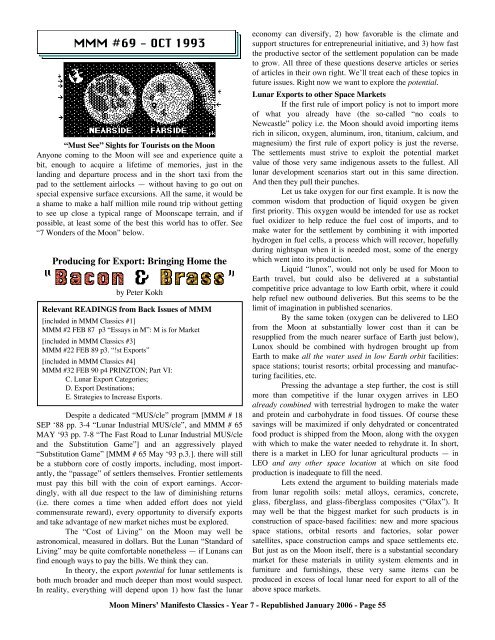MMM Classics Year 7: MMM #s 61-70
MMM Classics Year 7: MMM #s 61-70
MMM Classics Year 7: MMM #s 61-70
- No tags were found...
You also want an ePaper? Increase the reach of your titles
YUMPU automatically turns print PDFs into web optimized ePapers that Google loves.
<strong>MMM</strong> #69 - OCT 1993“Must See” Sights for Tourists on the MoonAnyone coming to the Moon will see and experience quite abit, enough to acquire a lifetime of memories, just in thelanding and departure process and in the short taxi from thepad to the settlement airlocks — without having to go out onspecial expensive surface excursions. All the same, it would bea shame to make a half million mile round trip without gettingto see up close a typical range of Moonscape terrain, and ifpossible, at least some of the best this world has to offer. See“7 Wonders of the Moon” below.Producing for Export: Bringing Home theby Peter KokhRelevant READINGS from Back Issues of <strong>MMM</strong>[included in <strong>MMM</strong> <strong>Classics</strong> #1]<strong>MMM</strong> #2 FEB 87 p3 “Essays in M”: M is for Market[included in <strong>MMM</strong> <strong>Classics</strong> #3]<strong>MMM</strong> #22 FEB 89 p3. “!st Exports”[included in <strong>MMM</strong> <strong>Classics</strong> #4]<strong>MMM</strong> #32 FEB 90 p4 PRINZTON; Part VI:C. Lunar Export Categories;D. Export Destinations;E. Strategies to Increase Exports.Despite a dedicated “MUS/cle” program [<strong>MMM</strong> # 18SEP ‘88 pp. 3-4 “Lunar Industrial MUS/cle”, and <strong>MMM</strong> # 65MAY ‘93 pp. 7-8 “The Fast Road to Lunar Industrial MUS/cleand the Substitution Game”] and an aggressively played“Substitution Game” [<strong>MMM</strong> # 65 May ‘93 p.3.]. there will stillbe a stubborn core of costly imports, including, most importantly,the “passage” of settlers themselves. Frontier settlementsmust pay this bill with the coin of export earnings. Accordingly,with all due respect to the law of diminishing returns(i.e. there comes a time when added effort does not yieldcommensurate reward), every opportunity to diversify exportsand take advantage of new market niches must be explored.The “Cost of Living” on the Moon may well beastronomical, measured in dollars. But the Lunan “Standard ofLiving” may be quite comfortable nonetheless — if Lunans canfind enough ways to pay the bills. We think they can.In theory, the export potential for lunar settlements isboth much broader and much deeper than most would suspect.In reality, everything will depend upon 1) how fast the lunareconomy can diversify, 2) how favorable is the climate andsupport structures for entrepreneurial initiative, and 3) how fastthe productive sector of the settlement population can be madeto grow. All three of these questions deserve articles or seriesof articles in their own right. We’ll treat each of these topics infuture issues. Right now we want to explore the potential.Lunar Exports to other Space MarketsIf the first rule of import policy is not to import moreof what you already have (the so-called “no coals toNewcastle” policy i.e. the Moon should avoid importing itemsrich in silicon, oxygen, aluminum, iron, titanium, calcium, andmagnesium) the first rule of export policy is just the reverse.The settlements must strive to exploit the potential marketvalue of those very same indigenous assets to the fullest. Alllunar development scenarios start out in this same direction.And then they pull their punches.Let us take oxygen for our first example. It is now thecommon wisdom that production of liquid oxygen be givenfirst priority. This oxygen would be intended for use as rocketfuel oxidizer to help reduce the fuel cost of imports, and tomake water for the settlement by combining it with importedhydrogen in fuel cells, a process which will recover, hopefullyduring nightspan when it is needed most, some of the energywhich went into its production.Liquid “lunox”, would not only be used for Moon toEarth travel, but could also be delivered at a substantialcompetitive price advantage to low Earth orbit, where it couldhelp refuel new outbound deliveries. But this seems to be thelimit of imagination in published scenarios.By the same token (oxygen can be delivered to LEOfrom the Moon at substantially lower cost than it can beresupplied from the much nearer surface of Earth just below),Lunox should be combined with hydrogen brought up fromEarth to make all the water used in low Earth orbit facilities:space stations; tourist resorts; orbital processing and manufacturingfacilities, etc.Pressing the advantage a step further, the cost is stillmore than competitive if the lunar oxygen arrives in LEOalready combined with terrestrial hydrogen to make the waterand protein and carbohydrate in food tissues. Of course thesesavings will be maximized if only dehydrated or concentratedfood product is shipped from the Moon, along with the oxygenwith which to make the water needed to rehydrate it. In short,there is a market in LEO for lunar agricultural products — inLEO and any other space location at which on site foodproduction is inadequate to fill the need.Lets extend the argument to building materials madefrom lunar regolith soils: metal alloys, ceramics, concrete,glass, fiberglass, and glass-fiberglass composites (“Glax”). Itmay well be that the biggest market for such products is inconstruction of space-based facilities: new and more spaciousspace stations, orbital resorts and factories, solar powersatellites, space construction camps and space settlements etc.But just as on the Moon itself, there is a substantial secondarymarket for these materials in utility system elements and infurniture and furnishings, these very same items can beproduced in excess of local lunar need for export to all of theabove space markets.Moon Miners’ Manifesto <strong>Classics</strong> - <strong>Year</strong> 7 - Republished January 2006 - Page 55















